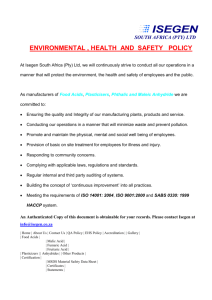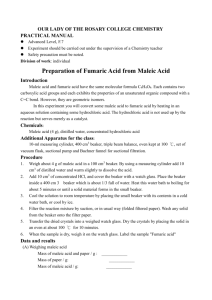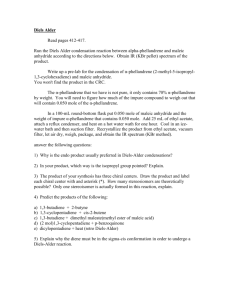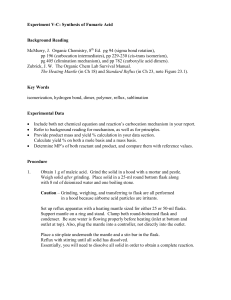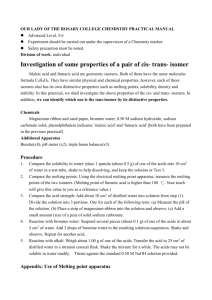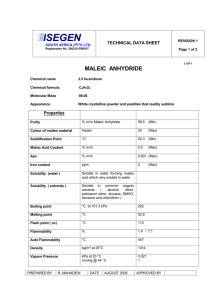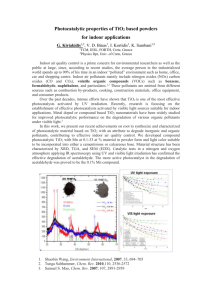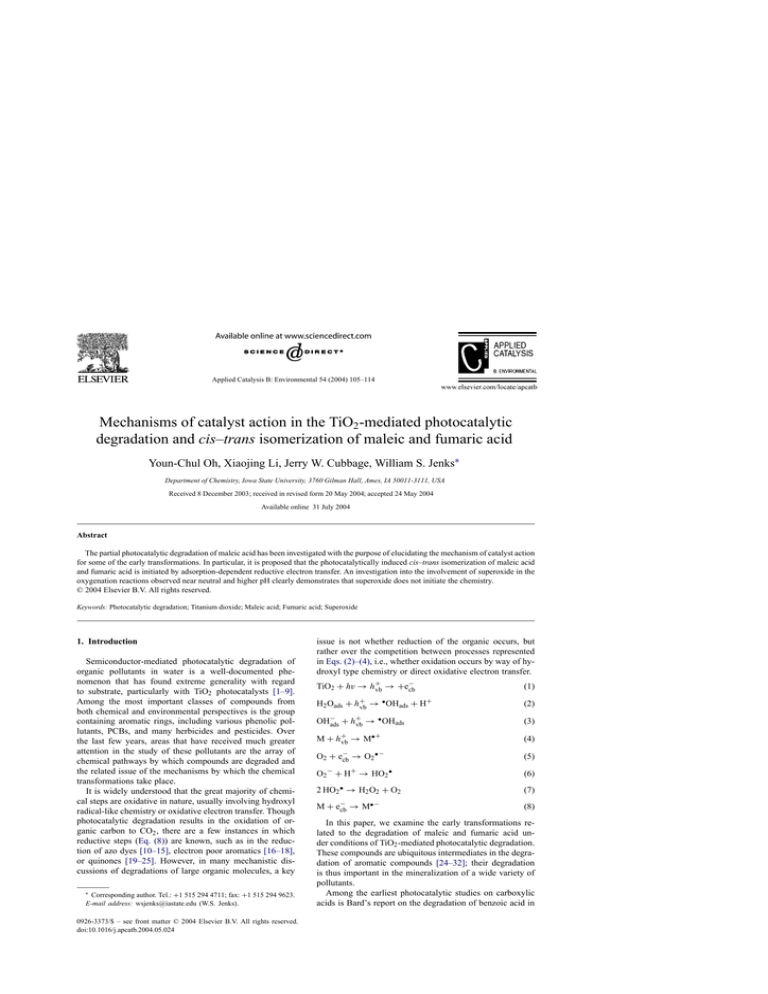
Applied Catalysis B: Environmental 54 (2004) 105–114
Mechanisms of catalyst action in the TiO2 -mediated photocatalytic
degradation and cis–trans isomerization of maleic and fumaric acid
Youn-Chul Oh, Xiaojing Li, Jerry W. Cubbage, William S. Jenks∗
Department of Chemistry, Iowa State University, 3760 Gilman Hall, Ames, IA 50011-3111, USA
Received 8 December 2003; received in revised form 20 May 2004; accepted 24 May 2004
Available online 31 July 2004
Abstract
The partial photocatalytic degradation of maleic acid has been investigated with the purpose of elucidating the mechanism of catalyst action
for some of the early transformations. In particular, it is proposed that the photocatalytically induced cis–trans isomerization of maleic acid
and fumaric acid is initiated by adsorption-dependent reductive electron transfer. An investigation into the involvement of superoxide in the
oxygenation reactions observed near neutral and higher pH clearly demonstrates that superoxide does not initiate the chemistry.
© 2004 Elsevier B.V. All rights reserved.
Keywords: Photocatalytic degradation; Titanium dioxide; Maleic acid; Fumaric acid; Superoxide
1. Introduction
Semiconductor-mediated photocatalytic degradation of
organic pollutants in water is a well-documented phenomenon that has found extreme generality with regard
to substrate, particularly with TiO2 photocatalysts [1–9].
Among the most important classes of compounds from
both chemical and environmental perspectives is the group
containing aromatic rings, including various phenolic pollutants, PCBs, and many herbicides and pesticides. Over
the last few years, areas that have received much greater
attention in the study of these pollutants are the array of
chemical pathways by which compounds are degraded and
the related issue of the mechanisms by which the chemical
transformations take place.
It is widely understood that the great majority of chemical steps are oxidative in nature, usually involving hydroxyl
radical-like chemistry or oxidative electron transfer. Though
photocatalytic degradation results in the oxidation of organic carbon to CO2 , there are a few instances in which
reductive steps (Eq. (8)) are known, such as in the reduction of azo dyes [10–15], electron poor aromatics [16–18],
or quinones [19–25]. However, in many mechanistic discussions of degradations of large organic molecules, a key
∗
Corresponding author. Tel.: +1 515 294 4711; fax: +1 515 294 9623.
E-mail address: wsjenks@iastate.edu (W.S. Jenks).
0926-3373/$ – see front matter © 2004 Elsevier B.V. All rights reserved.
doi:10.1016/j.apcatb.2004.05.024
issue is not whether reduction of the organic occurs, but
rather over the competition between processes represented
in Eqs. (2)–(4), i.e., whether oxidation occurs by way of hydroxyl type chemistry or direct oxidative electron transfer.
−
TiO2 + hv → h+
vb → +ecb
(1)
+
•
H2 Oads + h+
vb → OHads + H
(2)
+
•
OH−
ads + hvb → OHads
(3)
•+
M + h+
vb → M
(4)
−
O2 + ecb
→ O2 •−
(5)
O2 − + H+ → HO2 •
(6)
2 HO2 • → H2 O2 + O2
(7)
−
→ M•−
M + ecb
(8)
In this paper, we examine the early transformations related to the degradation of maleic and fumaric acid under conditions of TiO2 -mediated photocatalytic degradation.
These compounds are ubiquitous intermediates in the degradation of aromatic compounds [24–32]; their degradation
is thus important in the mineralization of a wide variety of
pollutants.
Among the earliest photocatalytic studies on carboxylic
acids is Bard’s report on the degradation of benzoic acid in
106
Y.-C. Oh et al. / Applied Catalysis B: Environmental 54 (2004) 105–114
aqueous media using platinized TiO2 [33]. Hydroxylation
of the aromatic ring to give salicylic acid and decarboxylation with oxidation to give phenol (presumably after
secondary reaction of Ph• with O2 ) were the initial transformations. Subsequent studies focused on the regiochemistry
of hydroxylation of benzoic acid and various halogenated
derivatives [34,35]. It was reported that hydroxylation of
monochlorophenols was not competitive with decarboxylation [35], but hydroxylation and decarboxylation were both
reported as primary reactions of polychlorophenols [36].
With aromatic polycarboxylic acids, both hydroxylation and
decarboxylation are reported as primary reaction pathways
[37].
There are also several publications reporting the degradation of various simple alkyl carboxylic acids. Again following early work by the Bard group, subsequent investigators
reported that there is a significant pH dependence on the balance between H2 and CH4 evolution from acetic acid and
that longer chain acids (e.g., butyric acid) gave evidence for
non-Kolbe pathways apparently initiated by hydrogen abstraction from the alkyl groups [38,39]. Production of chloride was also noted from chloroacetic acid derivatives [39].
Facts directly relevant to the present investigation emerge
from a recent study of the degradation of butyric acid [40].
The equilibrium concentration of butyric acid in aqueous
solution is higher at pH values above the acid dissociation
constant, implying that adsorption is stronger for the protonated acid. Nonetheless, the observed rate of degradation
was higher at pH 6.9 than that at pH 3.6. Product distributions varied, but this was attributed mainly to the different
distributions of species available to react after radical formation. The interpretation was based on a competition
between hole oxidation to give the decarboxylation and
chemistry initiated by hydrogen abstraction. Similar competitive chemistry was observed for the more functionalized
hydroxybutanedioic acid (malic acid) [41].
2,4-Dichlorophenoxyacetic acid (also known as the herbicide 2,4-D) and closely related compounds have received
special attention because of their direct environmental relevance [42–46]. Following the pattern outlined above, the
main initial product (2,4-dichlorophenol) derives from decarboxylation, but studies also report competitive arene
hydroxylation under some conditions. The most detailed
mechanistic work of these was again interpreted in terms
of a competition between direct hole oxidation and hydroxyl radical chemistry. At low pH (where we may infer
that the equilibrium adsorption constant is higher), it is asserted that direct oxidation by holes predominates, whereas
hydroxyl-type chemistry predominates in neutral and basic
solution. A purely radical mechanism based on competition
between surface-bound and bulk solution chemistry was
rejected on the basis of experiments using solution-phase
hydroxyl radical scavengers [42].
The most relevant study to the present work is a paper by
Franch et al. in which the degradation of oxalic, fumaric,
and maleic acids is reported [47]. Adsorption isotherms indi-
Scheme 1. Summary of pathways proposed by Franch et al. for photocatalytic degradation of maleic or fumaric acid at pH 3 in TiO2 slurries [47].
cate that approximately three times more maleic or fumaric
acid is bound to TiO2 at pH 3 than at pH 9. Like the butyric acid case, the initial degradation rate is modestly higher
at the higher pH, despite the poorer adsorption. These authors conclude that degradation occurs in the homogeneous
phase at high pH by means of solvated hydroxyl radicals.
Franch et al. also report a change in product distribution
with pH. At pH 3, the fastest process is cis–trans isomerization, which is attributed to interaction between the acids and
photogenerated holes. Aside from this, the major product is
reported to be acrylic acid (CH2 =CH–CO2 H), attributed to
photo-Kolbe chemistry. A small amount of photohydration
to malic acid is reported as well. Downstream intermediates
include acetic, oxalic, and formic acids. This is summarized
in Scheme 1. At pH 9, very little intermediate build-up is
reported aside from oxalic acid, implying that the first chemical step is slower than subsequent oxidations. In a related
study of the degradation of malic acid [41], maleic and fumaric acid are reported as observed intermediates, implying
that photoinduced dehydration may occur, as well as photoinduced hydration.
In this paper, we report an investigation of the degradation
of maleic and fumaric acids that begins in a manner parallel
to the work of Franch et al. [47]. Most of our product observations are in agreement with the previous work. We report
a series of experiments designed to elucidate more clearly
the mode of molecule-catalyst interaction that leads to various processes, including especially tartaric acid formation
and the cis–trans isomerization.
2. Experimental
2.1. Materials
All reagents were purchased from Aldrich and used without further purification unless otherwise indicated. Tartronic
acid and Superoxide dismutase (SOD, from bovine erythrocytes, 3000 units in 0.8 mg) were purchased from Sigma.
Y.-C. Oh et al. / Applied Catalysis B: Environmental 54 (2004) 105–114
Water was purified with a Milli-Q UV plus system (Millipore, resulting in a resistivity more than 18 M cm−1 ). TiO2
was Degussa P-25. The epoxides of sodium fumarate and
sodium maleate were prepared [48] by stereospecific epoxidation by the method of Payne and Williams [49]. Dihydroxyfumaric acid dimethyl ester was prepared by a reported
method [50].
2.2. Standard degradation conditions
Except as noted, degradations were carried out under
these standard conditions. A 100 mL aqueous sample containing 2.0 mM maleic acid (unless other concentration or
substrates, e.g., fumaric acid, are specified) and 50 mg suspended TiO2 was prepared. The pH of suspension was adjusted using HCl (pH 2), phosphate buffer (10 mM, pH 7.0),
or NaOH (pH 12). The mixture was treated in an ultrasonic bath for 5 min to disperse larger TiO2 aggregates and
purged with O2 for 20 min in the dark before the irradiation was started. The mixture was continuously purged with
O2 throughout irradiation. Irradiations were carried out with
magnetic stirring and a fan that kept the temperature at ambient levels in a Rayonet mini-photochemical reactor equipped
with eight 4 W “black light” fluorescent lamps which have a
broad emission spectrum centered at 360 nm. A few experiments were carried out with similar low-pressure fluorescent
tubes with emission centered at 300 nm, as noted. Both sets
of tubes were those sold by Southern New England Ultraviolet Company for use with the Rayonet reactors. After reaction, the mixtures were acidified, centrifuged, and passed
through 0.2 m Whatman filters to remove TiO2 . Water was
removed by freeze-drying. Small, calibrated quantities of
adipic acid were added after the photoreaction when an internal standard was required for quantification.
2.3. General analytical methods
Following the removal of water, the intermediate degradation products were identified and quantified as their
trimethylsilyl (TMS) derivatives, using GC-MS procedures
reported in our earlier work [24]. For analyses concerned
with product identification, parallel workups in which a
reduction step (NaBH4 or NaBD4 ) was inserted before the
silylation were also carried out [24]. The GC-MS instrument was a Varian 3400CX GC equipped with a 30 m DB-5
column, coupled to a Finnigan Magnum ion trap mass spectrometer. The temperature program was 120 ◦ C for 4 min,
followed by a ramp to 200 ◦ C at 5 ◦ C/min, then ramp at
15 ◦ C/min to 280 ◦ C. An HP 5890 gas chromatograph with
FID detection was also used for routine quantification.
2.4. Additional experimental conditions
2.4.1. Superoxide experiments
Potassium superoxide (KO2 ) is slightly soluble in dry
dimethyl sulfoxide (DMSO). Using the method of Valentine
107
[51], 0.15 M solutions of KO2 were prepared in the presence of 0.30 M 18-crown-6 [52]. Maintenance of the characteristic pale yellow color of these solutions was taken as
evidence that the superoxide remained. Reactions using either pyridine or DMSO as the solvent for maleic acid were
carried out with KO2 :maleic acid molar ratios of 1:1, 5:1,
1000:1, and 5:1 in the presence of 1% added water. The following example is representative of the reaction conditions.
To a solution of maleic acid (100 mL, 2 mM in DMSO), the
KO2 solution (50 mL) was added dropwise over the course
of 1 h. The solvent was evaporated under vacuum and the
residual material was silylated as usual and analyzed by
GC-MS. Neither degradation of maleic acid nor any new
organic compounds were observed.
2.4.2. Superoxide dismutase (SOD) experiments
The method of Pichat and co-workers [27,53–55] was
closely followed, and some of his experiments were duplicated as positive controls, as our results were universally
negative, i.e., there was little or no effect of adding SOD. In
the relevant experiments, maleic acid (39 mmol) and TiO2
(25 mg) were dispersed in 50 mL water, buffered at pH 7 with
the buffer supplied with the enzyme by Sigma. After ultrasonic treatment and O2 purging as usual, 1500 units of SOD
were introduced. The mixture was irradiated for 40 min, and
then worked up and analyzed in the usual fashion. Control
experiments using identical conditions, save that the SOD
enzyme was not added, produced identical results.
2.4.3. Fluoride experiments
These degradation reactions, workup, and analyses were
carried out in the standard fashion, with the following exceptions: sufficient NaF was added to raise the concentration
of the solution to 20 mM before addition of the TiO2 . The
pH of the slurry was adjusted to 3 to maximize surface coverage by fluoride ions [56,57]. As noted in the text, experiments were carried out both under conditions of constant
O2 purging and Ar purging. A merry-go-round apparatus,
which accommodated 10 mL, rather than 100 mL, samples,
was used to allow simultaneous photolyses of the O2 - and
Ar-purged samples.
3. Results and discussion
3.1. Product mixtures and exploratory degradations
Photocatalytic degradations of maleic acid (1) were carried out at pH 2, 7, and 12 using the light from broadly
emitting fluorescent tubes centered at 360 nm. The solutions
initially contained 2.0 mM maleic acid and 50 mg TiO2 in
100 mL O2 -saturated water, unless otherwise noted. Separate
control experiments showed that no degradation occurred in
the absence of TiO2 or irradiation. Experiments carried out
in the absence of O2 are described in more detail below,
but oxidative transformations were curtailed, compared to
108
Y.-C. Oh et al. / Applied Catalysis B: Environmental 54 (2004) 105–114
Table 1
Product distributions (mM) after 1 h irradiation for degradations of 2.0 mM
maleic acid (1) at pH 2, 7, and 12.
Scheme 2. Starting materials and observed products.
the ordinary conditions. We did not repeat the more extensive kinetic experiments of Franch, et al. but observed that
the degradations were faster at high pH, in line with their
reports [47].
We observed many of the same degradation intermediates as Franch, and a few more. This is probably reasonable, given that we used GC-MS detection, and they used
HPLC with UV detection. However, we did not observe
any acrylic acid, nor did Herrmann et al. in their study
of malic acid, which generated fumaric/maleic acid [41].
The four-carbon intermediates we observed included fumaric acid, malic acid, tartaric acid, dihydroxyfumaric acid,
and succinic acid as shown in Scheme 2. The presence of
dihydroxyfumaric acid (11) was deduced in the degradations at neutral pH from reductive workups using NaBD4 ,
which yield deuterated tartaric acid before silylation. The
ratio of mass intensities showed that slightly more than half
of the tartaric acid peak represented 11. Control experiments
showed that none of the reported compounds decomposed
under the experimental conditions (in the dark) throughout
the pH range used on the time-scale of our workups and
analyses.
Downstream degradation products were also observed.
The three-carbon intermediates included 3-oxopriopionic
acid, malonic acid, tartronic acid and 2-hydroxy-3-oxopropionic acid. The only identified 2-carbon product was oxalic
acid. We did not assay for either acetic or formic acid.
Small quantities of very high molecular weight compounds
(i.e., long GC retention times) were sometimes observed.
As previously noted [47], there is a distinct dependence of
the product mixtures on pH. The observed mixtures obtained
after a fixed irradiation period of one hour and silylative
workup are shown in Table 1 and Scheme 2. A representative
time-trace of intermediates of partial degradation at pH 12
is given as Fig. 1.
Control experiments, consisting of partial degradations
using 30 mM H2 O2 , in lieu of TiO2 , and irradiation centered
Compound
pH 2
pH 7
pH 12
1
2
3
4
5
6
7
8
9
10
1.43
0.20
0.011
0.036
0.058
0.012
0.005
0
0
0
1.34
0.01
0.19
0.015
0.09
0.008
0.004
0.029
0.029
0.09
0.66
0.019
0.21
0
0
0
0.004
0.25
0.369
0.006
at 300 nm, were carried out. These reactions produce free
hydroxyl and hydroperoxyl radicals. The observed early intermediates were very similar to those reported for the pH
7 TiO2 experiments (Table 1), regardless of the pH of the
H2 O2 experiments. Tartaric acid was the largest component
of the product mixture and fumaric acid was not observed.
Along with the dark controls, these experiments show that
the variation of products with pH shown in Table 1 is not
due to selective secondary degradation of intermediates, but
rather to differential rates of formation.
3.2. Isomerization mechanisms and the question of bulk
water versus surface-bound mechanisms
One of the most fundamental questions regarding the nature of the substrate-catalyst interaction in photocatalytic
degradation is whether reactions occur in the homogeneous
bulk phase or at the surface of the catalyst. It is not a
question that can be easily settled with steady-state kinetics
experiments: every plausible kinetic model based on surfacebound or homogeneous reactive intermediates reacting with
Fig. 1. The variation of the relative concentration of maleic acid (filled
circles) and oxalic acid (open circles), tartronic acid (squares) and tartaric
acid (triangles) at pH 12. The initial concentration of maleic acid was
2.0 mM.
Y.-C. Oh et al. / Applied Catalysis B: Environmental 54 (2004) 105–114
substrate yields kinetic information of the same form [58].
Thus, this is still a question of some dispute, though the more
conventional position at this point is that most reactions occur at the surface [59]. Nonetheless, previous investigators
argued that degradation at higher initial pH occurs in the
bulk water [47] because of the inverse relationship between
the degradation rate and adsorbed material. Additionally,
methanol, a known scavenger of HO• , was lowered the rate
of degradation by a factor of 2 at pH 9, but not at all at pH 3.
In other publications, we have suggested that hydroxyl-like
chemistry may occur at or near the surface of the catalyst,
but may have less rigorous requirements for specific adsorption modes or sites of adsorption than direct electron
transfer reactions between the substrate and the photoactivated TiO2 particle [24,29]. For example, surface-bound
hydroxyl radicals may be formed and remain stable until
diffusion either from bulk or through multilayer adsorption
brings an appropriate substrate in contact with the reactive
species. On the other hand, it is unlikely that a valence-band
hole will “wait around” for an organic substrate, rather than
finding a surface trap to make a surface-bound hydroxyl
radical.
The formation of fumaric acid from maleic acid at low pH
struck us as a reasonable case to test for surface-bound versus
bulk mechanisms. Also, the preliminary product study data
and H2 O2 photolyses suggested the possibility of an electron
transfer mediated reaction of a carboxylic acid that did not
lead to Kolbe chemistry, an unusual result.
Having established that HO• from H2 O2 photolysis does
not cause substantial cis–trans isomerization of maleic acid,
we investigated whether maleic acid acts as the electron
acceptor or donor with activated TiO2 . The first set of experiments compared normal O2 -saturated suspensions to otherwise identical Ar-purged suspensions, i.e., those without
O2 . This technique usually [60] results in the almost complete shutdown of degradative processes [24,25,29,61]; this
is universally attributed to efficient e− /h+ recombination
because there is no O2 available to act as an electron sink.
Inhibition occurs even when reactions are postulated to occur by oxidative electron transfer. However, if an alternative
electron acceptor is available, then reactivity can continue.
Standard maleic acid degradation suspensions, adjusted to
pH 2, were prepared such that half were O2 -purged as usual,
and half were Ar-purged, and they were simultaneously photolyzed. After 1 h of photolysis, the O2 -purged solutions had
a total conversion of 24%. This could be fully accounted
for by the appearance of fumaric acid (19%), malonic acid
(1.4%), succinic acid (2.7%), and malic acid (0.9%). The
Ar-purged solutions had a remarkable 83% conversion, of
which 82.5% was fumaric acid, with the observable remainder being succinic acid.
This experiment clearly shows that O2 in fact inhibits the
cis–trans isomerization of maleic acid, providing strong evidence that maleic acid acts as an electron acceptor. The simplest explanation for the increased efficiency in the absence
of oxygen is straightforward: under oxygenated conditions,
109
Scheme 3. A plausible schematic mechanism for cis–trans isomerization
that begins with reductive electron transfer. The protonation states of the
intermediates are speculative. (a) Rotation of the 3 e− p-system, probably
in the s time regime, assumed to be faster than proton transfer in the
acidic aqueous regime. (b) Protonation by low pH water assumed to be
faster than C2 –C3 bond rotation.
O2 acts as a competitor with maleic acid for accepting electrons from activated TiO2 . This interpretation requires that
superoxide not be an effective catalyst for cis–trans isomerization (as later shown, see below), that the radical anion
can isomerize, and that the radical anion is able to return
the electron to TiO2 or another species [62]. An outline of
a reasonable mechanism is given in Scheme 3.
It is well understood that the rotational barrier of
p-systems is drastically lowered by the addition of an electron because it occupies a formally antibonding orbital and
thus reduces the p bond order. We are unaware of definitive
experiments that give the timescale of bond rotation near
room temperature for appropriately close model systems,
but reasonable estimates based on epr experiments put the
cis–trans isomerization of some stilbene-like radical anions
in the microsecond time regime [63–65]. If this is faster than
protonation of the radical anion in aqueous acidic medium,
then the isomerization is accomplished at this stage. Return
of the electron to the TiO2 particle re-sets the stereochemistry of the double bond, as show in path (a). However, it
is not immediately clear whether the bond rotation of the
three-electron p-system is faster than the rate of protonation
of the anion radical in acidic media. Even if protonation
is fast, though, the essence of the mechanism is preserved,
as shown in path (b), in that oxidation of the (protonated)
radical will be quite facile.
These results led us to attempt to obtain a photocatalyzed
photostationary state of the maleic/fumaric acid mixture at
pH 2. These experiments were carried out under standard
pH 2 conditions, save that they were Ar-purged and that experiments were carried out using both maleic and fumaric
acids as starting materials. The results (Fig. 2) show that
essentially identical product mixtures are obtained and that,
as expected, fumaric acid is predominant. The final product
mixtures were very close to 92% fumaric acid, 7% maleic
110
Y.-C. Oh et al. / Applied Catalysis B: Environmental 54 (2004) 105–114
Fig. 2. A photostationary state arrived at by photocatalytic treatment of
either maleic or fumaric acid in the absence of O2 at pH 2. The final
proportion of fumaric acid is approximately 94%.
acid and 1% succinic acid, relative to the initial 2.0 mM concentration. It is interesting to note that the sole new product
observed is a reductive product from maleic/fumaric acid,
consistent with reductive electron transfer.
The O2 versus Ar experiment was repeated at pH 12,
where the acids are completely dissociated when in the
bulk phase. Under these conditions, after an hour, the
oxygen-saturated sample had lost 85% of its initial maleic
acid. Of that, only 2.5% was fumaric acid, with oxalic acid
making the bulk of the remainder (78%) along with small
quantities of the other usual materials, in agreement with
Franch’s reports. This latter result, along with the high conversion, obviously implies considerable downstream degradation. With Ar-purging, the total conversion was only 32%,
of which only 2.2% was fumaric acid. (Of the rest, 29.5%
was malic acid.) The most important result here is that Ar
purging does not completely shut down the reaction. A possible interpretation is that maleic acid can act as an electron
acceptor even at this high pH, but that in its deprotonated
state it is not as reactive to isomerization, perhaps because
it cannot undergo the necessary protonation for easy bond
rotation before back electron transfer or other chemistry
occurs (e.g., Scheme 3, path b). The binding isotherms of
Franch et al. [47] clearly demonstrate that there is still adsorption between maleic or fumaric acid and TiO2 even at
high pH, which is at least consistent with this speculation.
Another set of experiments was carried out in the presence
of fluoride anion. The addition of fluoride anion to TiO2 suspensions at low pH has been shown to produce homogenous
hydroxyl radicals and dramatically reduce the surface-bound
chemistry of phenol, a poorly adsorbing substrate [56,57].
Broadly speaking, this effect is attributed to displacement
of the surface hydroxyls by fluoride (maximized at pH 3–4)
and the concomitant change in surface properties. Water can
be oxidized to form hydroxyl radicals that are not bound to
the titania surface. For example, cyanuric acid, a compound
that does not adsorb to TiO2 in solution and is ordinarily
completely resistive to photocatalytic degradation by TiO2
slurries, is degraded by the TiO2 /F system [66]. Minero also
showed that TiO2 /F was able to degrade phenol in the absence of O2 much more rapidly than does “naked” TiO2 ,
though more slowly than in the presence of O2 . Presumably,
this derives from diffusing HO• effectively leading to more
efficient charge separation than is possible with naked TiO2 .
Degradations of maleic acid and fumaric acid were carried out at pH 3 in the absence of O2 with fluoride added,
and without fluoride (also without O2 ) as a control. The addition of fluoride was shown to severely curtail cis–trans isomerism. After 1 h of simultaneous photolysis of four maleic
acid samples, the product distribution for the control sample
was fumaric acid 6.0%, succinic acid 1.0%, malic acid 2.0%,
with a total conversion of 9.0% [67]. In the presence of fluoride, identical photolyses showed that the fumaric acid was
reduced to 1.8%. Malic acid was observed at 4.7%, for a total conversion of 6.5%. The clear implication of these data is
that inhibition of adsorption also inhibits cis–trans isomerization, again consistent with an electron transfer-mediated
mechanism.
Separate degradations were also carried out at pH 3 with
fluoride anion with O2 present. The mass balance was poor,
even at moderate conversion. At 31% conversion of maleic
acid, 0.3% oxalic acid, 1.6% fumaric acid, 0.6% tartronic
acid and 2.2% tartaric acid were detected. A similar result
showing very little isomerization was observed using fumaric acid as the starting material. The poor mass balance
again implies that further degradation of the early intermediates to CO2 was probably faster than the initial step. While
TOC experiments were not run to check this, the result is
consistent with Minero’s report of much greater mineralization with O2 than without [56,57]. Again, the implication
is that solution phase chemistry is not responsible for the
isomerization reaction.
As a final control, the substrate was modified by using the methyl ester (i.e., dimethyl maleate), rather than
the carboxylic acid. This would prevent a binding mode in
which C–O–Ti linkages were made. Using otherwise standard degradation conditions, at neutral pH, the major observed products were the dimethyl ester analogs of tartaric
acid, dihyroxyfumaric acid, and the monomethyl ester of
oxalic acid. At pH 2, however, the major product was dihyroxyfumaric acid diester, with almost no dimethyl fumarate
observed. We thus conclude that there is a quality about the
carboxylic acid functionality itself—differentiated from the
ester—that is required for efficient cis–trans isomerization.
We postulate that this property is related to a C–O–Ti binding mode analogous to that which was proposed (for example) by Moser et al. for aromatic acid derivatives [68], or
characterized by Martin et al. for 4-chlorocatechol [69]. The
relevant bond lengths make it seem most likely that a single
Ti atom is involved, but we cannot rule out a second one,
nor can we be sure whether one or both of the carboxylic
acids is adsorbed in this way. One might speculate that only
a single carboxylic group is chemisorbed in order to account
for the favoring of the trans-configured fumaric acid over
maleic acid, but this is not a requirement.
Y.-C. Oh et al. / Applied Catalysis B: Environmental 54 (2004) 105–114
With all these data in hand, the various mechanistic
possibilities for cis–trans isomerization at low pH may be
summarized:
• Direct photolysis might cause conventional photochemical cis–trans isomerization. This mechanism is eliminated
by the control experiments in which the TiO2 was not included and did not produce isomerization.
• Acid- or base-catalyzed dark reactions might cause isomerization. The dark control experiments eliminated this
pathway.
• Superoxide and/or HOO• might reversibly add to the
olefin, transiently eliminating the double bond and allowing isomerization. Experiments described in Section 3.3
eliminate this as a likely explanation.
• Maleic acid might serve as an electron donor to activated
TiO2 , transiently causing formation of the maleic acid
radical cation, which would have a considerably lower
barrier to rotation. This is the most conventional explanation [47,70,71]. One problem with this explanation is that
it is the same initial step invoked for the Kolbe-type decarboxylation, though it is possible that the same radical
cation could lead to both reactions. However, it is difficult to rationalize why the isomerization would be more
efficient in the absence of O2 at low pH than it is in the
presence of O2 if this mechanism were operating.
• Maleic acid can serve as an electron acceptor from photoactivated TiO2 , transiently causing formation of the
maleic acid radical anion, which would have a considerably lower barrier to rotation, with or without protonation, as illustrated in Scheme 3. This is the mechanism
we favor.
A further comment on our interpretive framework, which
varies slightly from that of Franch et al., is in order. The essential distinction is that while both they and we postulate
two types of reactivity (of which one is electron transfer at
the surface), we believe that there is no requirement for their
assertion that the second type is reaction in the bulk phase
of the water. The distinction in reactivity between methyl
maleate and maleic acid, along with the TiO2 /F results support the idea that the predominant chemistry at low pH,
i.e., cis–trans isomerization, requires surface adsorption, but
does not speak to the higher pH results, where the product
distributions are different.
We have reported analogous changes in chemistry from
oxidative electron transfer chemistry to hydroxyl-like chemistry with the change of phenolic OH-groups to methoxy
groups on benzene rings [29]. In those experiments [29], adsorption was modified by the capping of the phenols and its
resulting prevention of C−O−Ti type adsorption, rather than
by changing pH. We argued that the hydroxyl type chem-
111
istry could be due to non-specific binding with the titania
surface and/or reactions very near the surface. Alcohol additives were more effective in slowing down the hydroxyl-type
chemistry than the electron transfer chemistry, but they were
also shown to displace the poorly binding substrates; these
were also the same ones that suffer the great proportion
of hydroxyl-type chemistry. Very similar arguments can be
used to explain the dependence of the products on pH for
maleic acid. Thus, while the current data certainly do not
eliminate the possibility of bulk phase TiO2 -mediated reactivity at neutral and basic pH, we find nothing compelling
about either our data set or that of Franch et al. [47] to confirm it. However, we remain compelled by the experiments
of Minero and co-workers (e.g., [56,57,59]), and feel that
this should be the assumption in the absence of convincing
evidence to the contrary in support for homogeneous-phase
chemistry.
3.3. Mechanisms of oxygenation reactions
Given our interpretation that the cis–trans isomerization
is best explained by reversible reductive electron transfer
chemistry, we wished to explore the possibility that some
of the oxidation (or, perhaps more properly, oxygenation)
products might begin with a step that itself was formally
reductive in nature. The most obvious candidate was reaction
between maleic acid and superoxide near neutral pH, where
the latter is largely deprotonated and nucleophilic. While the
acids are also largely deprotonated in homogeneous solution,
they might still be associated with the titania in such a way
as to make them behave like the ester, rather than the anion
or dianion, and thus act as good Michael acceptors. Though
the adsorption coefficient is not as high at high pH as it is in
acidic solution [47], we were intrigued with the possibility
that a surface-bound tartaric acid might suffer from attack by
nucleophilic hydroperoxyl/superoxide species, rather than
electrophilic hydroxyl species, as outlined in Scheme 4.
At pH 7 and 12, the HOO• /O2 •− equilibrium lies far to
the side of superoxide. It is obviously more nucleophilic
than the conjugate acid, making step A more reasonable.
Further, we hypothesize that the substrate is surface-bound
to maintain its effectively “protonated” state with regard to
Michael-type attack at the -position, relative to the adsorbing acid group. Step B is thermodynamically downhill and
related reactions are well known in the organic literature
[72–78]. In aqueous solution, 13 is an obvious precursor to
9 by either acid or base catalyzed ring opening. The path
shown by steps D–F is the more conventional mechanism
for oxidative chemistry under these and similar conditions
[79,80]. We thus sought tests to explore plausibility of the
path beginning with step A. The first was to test for the intermediacy of 13.
Compound 13, the epoxide of maleic acid, was prepared
as its sodium salt. It was hypothesized that a competition
between hydrolysis and oxidation might lead to 9 and 11.
However, photocatalytic treatment of 13 did not produce
112
Y.-C. Oh et al. / Applied Catalysis B: Environmental 54 (2004) 105–114
Scheme 4. Possible mechanisms for formation of 9 and 11. For simplicity, free, rather than surface-bound compounds are shown. It is understood that
protonation states will vary, though protons also stand in for potential Ti atoms in various potential bound states in the scheme.
detectable amounts of 11 when degradations were carried
out to low conversion at pH 2, 7, or 12. The major product
at pH 2 was oxalacetic acid (16), with some tartaric acid
formed. At pH 7, these were observed in reverse order of
importance. At pH 12, even at low conversion, more products
were observed: 16 > 3 > 9 > 8 > 4.
A hypothesis that might have accounted for the lack of
observation of 16 in the degradations of maleic acid is that
16 is particularly rapidly degraded. In fact, degradations beginning with 16 at 2 mM did produce intermediates that
were observed in maleic acid degradations. At pH 2, tartaric
acid and dihydroxyfumaric acid were the most predominant
products. At pH 7, tartaric acid was predominant. At pH
12, compounds 4, 8, 3, and 9 were observed, in that order
of abundance, indicating that decarboxylation reactions had
become competitive with initial hydroxylations. However,
degradations of 16 were not significantly more rapid than
those of any other substrate, and the very fact that it was
so easily observed in the degradations of 13 casts doubt on
the idea that its degradation is particularly rapid in other
experiments.
It was also plausible that superoxide was involved in the
reaction, but that the other details of the A–B–C pathway
of Scheme 3 were incorrect, i.e., that 12 does not form an
epoxide. Thus, we sought more direct evidence regarding
superoxide itself.
Following the precedent of Pichat and coworkers
[27,53–55], degradations were carried out in the presence
of commercial samples of superoxide dismutase (SOD), an
enzyme that catalyzes the disproportionation of superoxide to hydrogen peroxide and O2 . As a first step, selected
results from the Pichat lab were reproduced. In these, addition of superoxide dismutase hindered the degradation of
dimethoxy benzene and quinoline near neutral pH. With
maleic acid at near-neutral pH (using the commercial buffer
supplied with the enzyme), the presence of SOD did not
qualitatively affect the rate of degradation. Neither did it
suppress tartaric acid formation, which was still the major
four-carbon intermediate. Small quantities of fumaric acid
were also observed, consistent with ordinary degradations
at this pH. This suggests that superoxide is not the primary
reactant in formation of tartaric acid.
Finally, maleic acid was treated with superoxide solutions
formed by dissolving commercially available KO2 in dry
DMSO containing 18-crown-6. Reactions were carried out
in pyridine, anhydrous DMSO, and wet DMSO with superoxide:maleic acid ratios of 1:1, 5:1, and 1000:1. No maleic
acid-derived products were observed at the lower ratios of
KO2 :1. A trace quantity of fumaric acid (and oxalic acid)
was observed after an hour of treatment at the 1000:1 ratio.
These conditions are at orders of magnitude higher concentrations of superoxide than is plausible under normal photocatalytic conditions, though the solvent differs and the TiO2
surface does not serve to pre-organize the mixture. No tartaric acid, oxalacetic acid or any three-carbon compounds
were observed in any of these experiments.
We thus conclude that superoxide is not an important initiating reactant in the formation of any of the four-carbon
intermediates, including the cis–trans isomerization products under the TiO2 -mediated conditions. In the absence
of evidence to the contrary, we thus favor the conventional
hydroxyl addition steps as the primary reaction mode to
get to the oxygenated products. We also eliminate the reversible addition of superoxide as an important mechanism
for cis–trans isomerization of maleic and fumaric acids.
4. Conclusions
Partial photocatalytic degradation of maleic acid gives
rise to most of the plausible oxygenated compounds with
four carbons or fewer. Our observations are generally in line
with the recent report of Franch, et al. [47], save that we do
not observe by GC-MS acrylic acid, which they report with
HPLC and UV detection. The cis–trans isomerism of maleic
Y.-C. Oh et al. / Applied Catalysis B: Environmental 54 (2004) 105–114
acid under acidic conditions is proposed to occur by way of
reductive electron transfer to the adsorbed acid. The bases
for this conclusion include the acid’s superior adsorption at
low pH [47], the near exclusivity of this process in the absence of O2 (which usually acts as an electron acceptor),
the increase in observed isomerization rate in the absence of
O2 (contrary to the great majority of photocatalytic degradation processes), and the suppression of isomerization with
the addition of fluoride to the system.
An investigation into the possibility that other reactions
begin with the reaction of maleic acid with superoxide in
a similar electron/nucleophile-accepting mode produced results in clear contradiction with this idea. It is presumed
that the formation of tartaric acid and dihydroxyfumaric
acid—along with other smaller intermediates—occurs by
conventional mechanisms beginning with hydroxyl attack
on the substrate.
Acknowledgements
The support of this research by the IPRT Center for Catalysis and, in part, the National Science Foundation is gratefully acknowledged. We gratefully acknowledge helpful
conversations with Prof. James Espenson and Gabor Lente.
References
[1] D.F. Ollis, H. Al-Ekabi (Eds.), Photocatalytic Purification and Treatment of Water and Air, Elsevier, New York, 1993, p. 820.
[2] G.R. Helz, R.G. Zepp, D.G. Crosby (Eds.), Aquatic and Surface
Photochemistry, Lewis Publishers, Boca Raton, 1994.
[3] D.S. Bhatkhande, V.G. Pangarkar, A.A.C.M. Beenackers, J. Chem.
Technol. Biotechnol. 77 (2002) 102.
[4] U. Stafford, K.A. Gray, P.V. Kamat, Heterog. Chem. Rev. 3 (1996)
77.
[5] P.V. Kamat, K. Vinodgopal, in: V. Ramamurthy, Schanze, K., Molecular and Supramolecular Photochemistry: Organic and Inorganic Photochemistry, Marcel Dekker, New York, 1998, p. 307.
[6] M.R. Hoffmann, S.T. Martin, W. Choi, D.W. Bahnemann, Chem.
Rev. 95 (1995) 69.
[7] D. Bahnemann, in: P. Boule (Ed.), Handbook of Environmental
Chemistry, Springer, Berlin, 1999, p. 285.
[8] A. Mills, S. Le Hunte, J. Photochem. Photobiol. A 108 (1997) 1.
[9] N. Serpone, Res. Chem. Intermed. 20 (1994) 953.
[10] C. Hu, J.C. Yu, Z. Hao, P.K. Wong, Appl. Catal. B 42 (2003) 47.
[11] H. Tada, M. Kubo, Y.-I. Inubushi, S. Ito, Chem. Commun. (2000)
977.
[12] G.T. Brown, J.R. Darwent, J. Chem. Soc., Faraday Trans. 1 Phys.
Chem. Condensed Phases 80 (1984) 1631.
[13] K. Kunitou, S. Maeda, S. Hongyou, K. Mishima, Canadian J. Chem.
Eng. 80 (2002) 208.
[14] K. Tanaka, K. Padermpole, T. Hisanaga, Wat. Res. 34 (1999) 327.
[15] D. You, H. Xie, S. Dai, J. Environ. Sci. (China) 4 (1992) 97.
[16] M. Muneer, D. Bahnemann, Water Sci. Technol. 44 (2001) 331.
[17] M. Muneer, D. Bahnemann, Appl. Catal. B 36 (2002) 95.
[18] M. Muneer, J. Theurich, D. Bahnemann, J. Photochem. Photobiol.
A 143 (2001) 213.
[19] D. Bahnemann, Handbook of Environmental Chemistry, vol. 2, 1999,
p. 285.
113
[20] C. Richard, New J. Chem. 18 (1994) 443.
[21] C. Richard, P. Boule, New J. Chem. 18 (1994) 547.
[22] C. Richard, P. Boule, Sol. Energy Mater. Sol. Cells 38 (1995)
431.
[23] J. Theurich, M. Lindner, D.W. Bahnemann, Langmuir 12 (1996)
6368.
[24] X. Li, J.W. Cubbage, T.A. Tetzlaff, W.S. Jenks, J. Org. Chem. 64
(1999) 8509.
[25] X. Li, J.W. Cubbage, W.S. Jenks, J. Org. Chem. 64 (1999) 8525.
[26] C. Bouquet-Somrani, A. Finiels, P. Graffin, J.-L. Olivé, Appl. Catal.
B 8 (1996) 101.
[27] L. Amalric, C. Guillard, P. Pichat, Res. Chem. Intermed. 21 (1995)
33.
[28] P. Pichat, Water Sci. Technol. 35 (1997) 73.
[29] X. Li, J.W. Cubbage, W.S. Jenks, J. Photochem. Photobiol. A 143
(2001) 69.
[30] J.M. Tseng, C.P. Huang, Water Sci. Technol. 23 (1991) 377.
[31] E. Vulliet, C. Emmelin, J.-M. Chovelon, C. Guillard, J.-M. Herrmann,
Appl. Catal. B 38 (2002) 127.
[32] M. Stylidi, D.I. Kondarides, X.E. Verykios, Appl. Catal. B 40 (2003)
271.
[33] I. Izumi, F.-R.F. Fan, A.J. Bard, J. Phys. Chem. 85 (1981) 218.
[34] R.W. Matthews, J. Chem. Soc., Faraday Trans. 1 80 (1984) 457.
[35] H. Tahiri, Y. Ait Ichou, J.-M. Herrmann, J. Photochem. Photobiol.
A 114 (1998) 219.
[36] A.B. Prevot, E. Pramauro, Talanta 48 (1999) 847.
[37] A. Assabbane, A. Boussaoud, A. Albourine, Y. Aitichou, M.
Petit-Ramel, Ann. Chim. (Paris) 22 (1997) 301.
[38] T. Sakata, T. Kawai, K. Hashimoto, J. Phys. Chem. 88 (1984)
2344.
[39] A. Chemseddine, H.P. Boehm, J. Mol. Catal. 60 (1990) 295.
[40] C. Guillard, J. Photochem. Photobiol. A 135 (2000) 65.
[41] J.-M. Herrmann, H. Tahiri, C. Guillard, P. Pichat, Catal. Today 54
(1999) 131.
[42] Y. Sun, J.J. Pignatello, Environ. Sci. Technol. 29 (1995) 2065.
[43] A. Topalov, B. Abramovic, D. Molnár-Gábor, J. Csanádi, O. Arcson,
J. Photochem. Photobiol. A 140 (2001) 249.
[44] S. Horikoshi, H. Hidaka, N. Serpone, J. Photochem. Photobiol. A
159 (2003) 289.
[45] K. Tanaka, K.S.N. Reddy, Appl. Catal. B 39 (2002) 305.
[46] M. Trillas, J. Peral, X. Domenech, Appl. Catal. B 5 (1995) 377.
[47] M.I. Franch, J.A. Ayllon, J. Peral, X. Domenech, Catal. Today 76
(2002) 221.
[48] 1H NMR (D2 O) ␦ 3.61 (cis) 3.32 (trans).
[49] G.B. Payne, P.H. Williams, J. Org. Chem. 24 (1959) 54.
[50] E.F. Hartree, J. Am. Chem. Soc. 75 (1953) 6244.
[51] J.S. Valentine, A.B. Curtis, J. Am. Chem. Soc. 97 (1975) 224.
[52] C.J. Pedersen, H.K. Frensdorff, Angew. Chem. Int. Ed. Engl. 11
(1972) 16.
[53] L. Amalric, C. Guillard, P. Pichat, Res. Chem. Int. 20 (1994)
579.
[54] L. Cermenati, A. Albini, P. Pichat, C. Guillard, Res. Chem. Intermed.
26 (2000) 221.
[55] L. Cermenati, P. Pichat, C. Guillard, A. Albini, J. Phys. Chem. B
101 (1997) 2650.
[56] C. Minero, G. Mariella, V. Maurino, D. Vione, E. Pelizzetti, Langmuir
16 (2000) 8964.
[57] C. Minero, G. Mariella, V. Maurino, E. Pelizzetti, Langmuir 16
(2000) 2632.
[58] C.S. Turchi, D.F. Ollis, J. Catal. 122 (1990) 178.
[59] C. Minero, F. Catozzo, E. Pelizzetti, Langmuir 8 (1992) 481.
[60] We cite our own work here not out of vanity or because others have
not done it, but because we wish to stress that the conditions we
are speaking of are identical to those used with other compounds,
i.e., done in our hands with our exact procedures.
[61] Y.-C. Oh, Y. Bao, W.S. Jenks, J. Photochem. Photobiol. A 160 (2003)
69.
114
Y.-C. Oh et al. / Applied Catalysis B: Environmental 54 (2004) 105–114
[62] This interpretation is also consistent with our lack of observation
of acrylic acid, a product that would likely result from oxidative
electron transfer.
[63] B. Kalyanaraman, R.P. Mason, R. Rowlett, L.D. Kispert, Biochim.
Biophys. Acta 660 (1981) 102.
[64] R. Chang, C.S. Johnson, J. Chem. Phys. 41 (1964) 3272.
[65] C.S. Johnson, R. Chang, J. Chem. Phys. 43 (1965) 3183.
[66] Y.-C. Oh, W.S. Jenks, J. Photochem. Photobiol. A 162 (2004)
323.
[67] As noted in the Experimental section, a different sample holding
system was used for these experiments, so the extents of conversions
cannot be directly compared to those in Table 1, despite the like
irradiation times.
[68] J. Moser, S. Punchihewa, P.P. Infelta, M. Grätzel, Langmuir 7 (1991)
3012.
[69] S.T. Martin, J.M. Kesselman, D.S. Park, N.S. Lewis, M.R. Hoffmann,
Environ. Sci. Technol. 30 (1996) 2535.
[70] M.A. Fox, C.C. Chen, J. Am. Chem. Soc. 103 (1981) 6757.
[71] J. Araña, O. Gonzalez Diaz, M. Miranda Saracho, J.M. Dona
Rodriguez, J.A. Herrera Melian, J. Perez Pena, Appl. Catal. B 36
(2002) 113.
[72] J.C. Rienstra-Kracofe, W.D. Allen, H.F.I. Schaefer, J. Phys. Chem.
A 104 (2000) 9823.
[73] M.S. Stark, J. Am. Chem. Soc. 122 (2000) 4162.
[74] R.R. Baldwin, D.R. Stout, R.W. Walker, J. Chem. Soc., Faraday
Trans. 87 (1991) 2147.
[75] R.R. Baker, R.R. Baldwin, A.R. Fuller, R.W. Waker, J. Chem. Soc.,
Faraday Trans. 1 71 (1975) 736.
[76] R. Ruiz Diaz, K. Selby, D.J. Waddington, J. Chem. Soc., Perkin
Trans. 2 (1975) 758.
[77] N.D. Stothard, R.W. Walker, J. Chem. Soc., Faraday Trans. 86 (1990)
2115.
[78] P. Koelewijn, Recueil 91 (1972) 759.
[79] C. von Sonntag, H.-P. Schuchmann, Angew. Chem. Int. Ed. Engl.
30 (1991) 1229.
[80] G.A. Russell, J. Am. Chem. Soc. 79 (1957) 3871.

